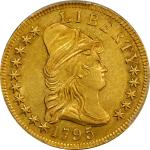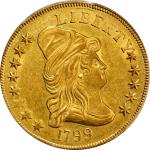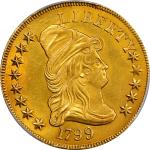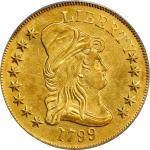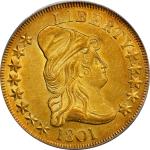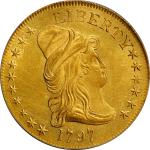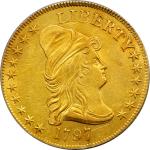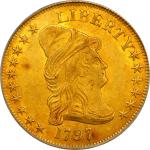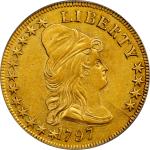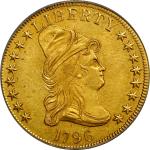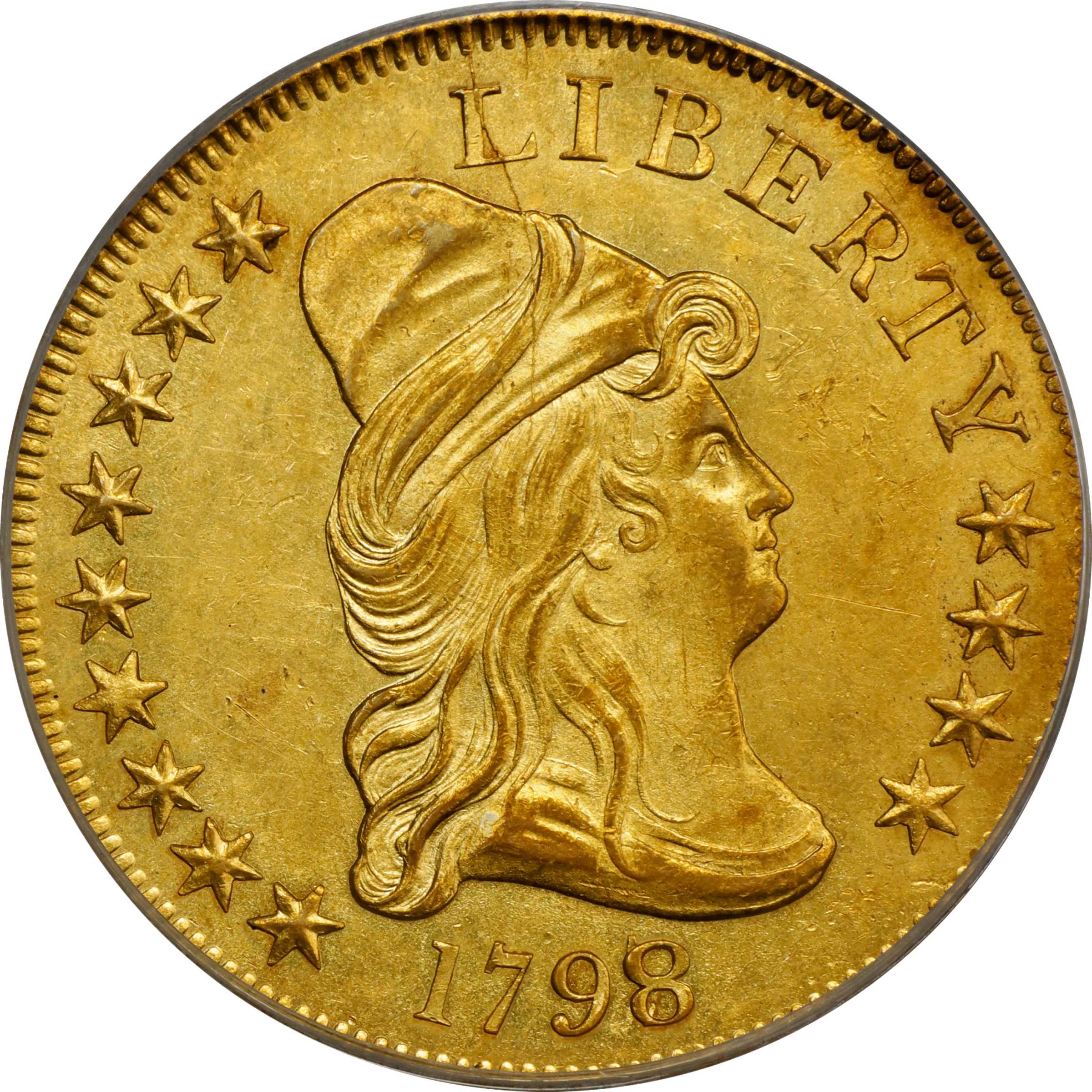1798/7 Capped Bust Right Eagle. BD-1, Taraszka-9. Rarity-4+. Stars 9x4. MS-61 (PCGS). <strong>Type and Style:</strong> Type II: Capped Bust Right, Heraldic Eagle. Style IV: Head of 1795 with 13 stars arranged nine left, four right; Reverse of 1797B with 13 stars in the field below the clouds and a short, thin neck on the eagle. The head punch is attributed to a hub prepared by Robert Scot, while the eagle punch is often attributed to a hub prepared by John Smith Gardner.<p><strong>Die Variety:</strong> BD-1, Taraszka-9, Breen 1-A, HBCC-3180. This variety represents the only use of this obverse die in the Capped Bust Right eagle series, the 9x4 star arrangement definitive. The same reverse die was used to strike both varieties of the 1798/7 eagle, and it was later used by the Mint in the 1797 BD-3 pairing.<p><strong>Die State:</strong> BD Die State c/b. This is an advanced obverse die state known for the 1798/7 BD-1 eagle, with the most prominent crack from the dentil above the L in LIBERTY, down through that letter and Libertys cap before terminating in the hair curls below the lower edge of the cap. Another, lighter crack originates at the upper right border, bisects the letter R in LIBERTY, and continues to the lower part of the front hair curl. There is only a single reverse die state currently known for this variety, and it is attributable by light cracks through the tops of the letters UN and TED in UNITED, seen faintly on the present example. Die State a/a coins, with no obverse or reverse cracks, are currently unknown for the 1798/7 BD-1 eagle and may not exist.<p><strong>Estimated Mintage for the Issue:</strong> Walter Breen asserts that 1,742 eagles were struck from 1798-dated dies, composed of the 900 coins delivered on February 17, 1798, and the 842 pieces delivered on February 28 of that year. Based on a more exhaustive study of die states and emission sequences, as well as modern estimates on the number of coins extant, Dannreuther provides a broader range of 1,500 to 2,442 coins struck for the 1798/7 eagle as an issue, a figure comprising both varieties of the overdate.<p><strong>Estimated Mintage for the Variety:</strong> Numismatic tradition accepts a mintage of 900 coins for the 1798/7 Stars 9x4 eagle, based on Breens assertion that the 900 eagles delivered on February 17, 1798, were the only examples produced from this die pairing. Since 80 to 100 coins are believed extant from this die marriage, however, Dannreuther asserts that the mintage of this variety was likely on the order of 1,200 to 1,600 coins, some of which were undoubtedly delivered on and/or after February 28, 1798.<p><strong>Estimated Surviving Population for the Variety:</strong> Eighty to 100 coins are believed extant in all grades (per Dannreuther).<p><strong>Strike:</strong> This is a boldly to sharply struck early eagle with only trivial lack of detail along the lower right obverse border, at star 4 on the same side, and over the highest elements of the design, where slight softness of strike mingles with trivial numismatic handling that helps to explain the MS-61 grade from PCGS.<p><strong>Surfaces:</strong> Both sides exhibit moderately reflective satin luster with a hint of green-gold color. A few minor marks are noted, consistent with the assigned grade, but none are serious. A planchet drift mark (as made) is out of the way at the reverse border between the letters AM in AMERICA - a useful provenance marker. The eye appeal is superior for the assigned grade.<p><strong>Commentary:</strong> Although the rarity of this date has been overstated in the past (Breen, for one, estimated that only 31 to 33 1798/7 eagles of both varieties were extant), this issue still ranks as the second scarcest in the early eagle series after the final year 1804 Crosslet 4. BD-1 is the more readily available of the two varieties of this issue. The 1798 as an issue is significant as the first in the early eagle series to feature overdate dies, both obverses having the digit 8 cut over a 7. It is also significant as the first in its series with 13 stars on the obverse, and clearly both obverse dies were prepared after the Mint abandoned the idea of adding a star for each new state that joined the Union. After Tennessees admission brought the requisite number of stars under that plan to 16, overcrowding of the design clearly became a problem, leading to the decision to feature only 13 stars in honor of the original 13 states. Mint employees initially experimented with the arrangement of the 13 stars on the obverse dies of the eagle, with the two 1798/7 varieties displaying different arrangements of 9x4 and 7x6, respectively. In the end, neither of those arrangements were accepted for long term use, as the Mint instead decided on the 8x5 arrangement for all remaining Capped Bust Right eagles beginning with the 1799-dated coins. As such, the 1798/7 BD-1, with its 9x4 star arrangement, is unique in the early eagle series and represents a must-have variety for the serious gold type collector. This is one of the finest certified examples of the variety. With an illustrious provenance, as well, this coin is sure to find its way into another world class early gold cabinet. PCGS# 8560. NGC ID: BFYR. PCGS Population: 3; 4 finer (MS-63 finest). From the Harvey B. Jacobson Jr. Collection. Earlier ex RARCOA, February 1, 1975; Harry W. Bass, Jr.; our (Bowers and Merenas) sale of the Harry W. Bass, Jr. Collection, Part III, May 2000, lot 561; Jim McGuigan, 2003.





